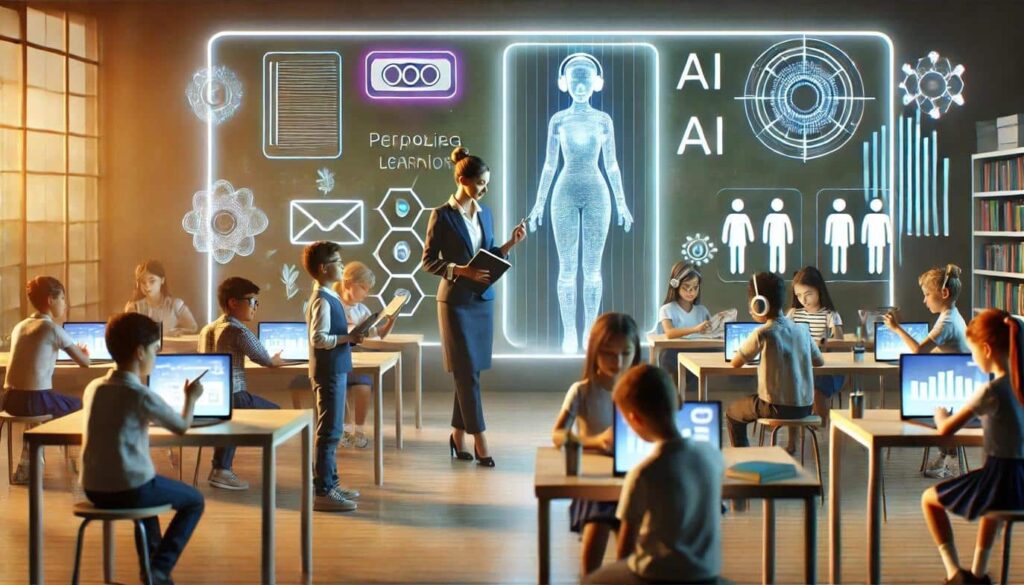The education sector is undergoing its most significant transformation since the invention of the printing press, with Artificial Intelligence (AI) and adaptive learning technologies revolutionizing how students learn and teachers instruct. By 2025, AI-powered tools like ChatGPT, intelligent tutoring systems, and personalized learning platforms will be ubiquitous in classrooms worldwide, creating more engaging, efficient, and equitable education systems.
The global AI education market is projected to reach $25.7 billion by 2027, driven by advancements in natural language processing (NLP), machine learning, and generative AI. This comprehensive guide explores how AI is reshaping education in 2025, from automated grading and virtual tutors to AI-generated lesson plans and predictive analytics for student success.
1. The AI Education Revolution: Why 2025 is a Tipping Point
Education has traditionally been slow to adopt technology, but AI is breaking down barriers with:
✔ Personalized learning at scale – AI adapts to each student’s pace and learning style
✔ 24/7 tutoring via ChatGPT-like assistants – Instant homework help and explanations
✔ Automated administrative tasks – Freeing up 20+ hours weekly for teachers
✔ Early intervention systems – Predicting student struggles before they happen
A McKinsey report estimates AI could help students gain 1-2 years of additional learning by 2025 through personalized education approaches.
2. ChatGPT in the Classroom: Beyond Basic Chatbots
While ChatGPT made headlines in 2023, by 2025 it will be deeply integrated into education:
A. AI Teaching Assistants
- Real-time Q&A during lessons without interrupting class flow
- Multilingual support for ESL students (translating + explaining concepts)
- Homework troubleshooting with step-by-step guidance (not just answers)
Example: Khan Academy’s “Khanmigo” uses GPT-4 to tutor students while preventing cheating.
B. AI-Powered Lesson Planning
- Automated curriculum generation based on state standards
- Dynamic content adjustment based on class comprehension levels
- Custom worksheet creation in seconds
Case Study: A Texas school district reduced lesson planning time by 65% using Education Copilot’s AI.
C. Ethical Considerations
- AI detection tools like Turnitin’s “Authorship Investigate”
- Prompt engineering curricula teaching proper AI use
- “Human-in-the-loop” systems ensuring teacher oversight
3. Adaptive Learning Platforms: The End of One-Size-Fits-All Education
Traditional classrooms teach 25 students the same way. AI changes this in 2025:
How Adaptive Learning Works:
- Diagnostic assessments pinpoint knowledge gaps
- AI algorithms create personalized learning paths
- Continuous adjustments based on performance
- Predictive analytics flag at-risk students
Leading 2025 Platforms:
- Century Tech: Uses neuroscience + AI to optimize learning
- DreamBox Learning: Adapts math problems in real-time
- Squirrel AI: China’s AI tutor achieving 20% better test scores
Impact: Arizona State University saw pass rates increase 18% with adaptive learning.
4. Automated Grading & Feedback: Saving Teachers 10+ Hours Weekly
Teachers spend 50% of their time on grading and admin. AI is changing this:
2025 AI Grading Capabilities:
✔ Essay scoring with nuanced feedback (e.g., Gradescope)
✔ Math problem checking with step-by-step corrections
✔ Speech/pronunciation analysis for language learning
✔ Plagiarism detection with AI authorship identification
Example: Turnitin’s AI writing detection now identifies 97% of ChatGPT-generated content.
5. AI for Special Education: Breaking Down Learning Barriers
AI is proving particularly transformative for students with:
- Dyslexia: Tools like Microsoft’s Immersive Reader
- Autism: Social skills training via VR + AI
- Visual/hearing impairments: Real-time captioning/descriptions
Breakthrough: Cognii’s virtual assistant helps special needs students via Socratic dialogue methods.
6. Predictive Analytics: Preventing Dropouts Before They Happen
AI systems now predict student outcomes with 92% accuracy by analyzing:
- Assignment completion rates
- Login frequency
- Discussion forum engagement
- Past performance patterns
Case Study: Georgia State’s AI advising system reduced dropout rates by 22%.
7. Global Classroom: AI-Powered Language Translation
By 2025, real-time translation AIs will enable:
- Instant lecture translation for international students
- Bilingual tutoring sessions
- Global collaborative projects without language barriers
Example: Zoom’s AI translation now supports 12 languages in education settings.
8. Challenges & Ethical Considerations
While promising, AI in education faces hurdles:
- Data privacy concerns (COPPA/GDPR compliance)
- Algorithmic bias risks
- Over-reliance on technology
- Teacher training requirements
Solution: The EU’s AI Act now includes specific education AI regulations.
9. The Future of AI in Education (2025-2030)
Coming advancements include:
- Emotion-sensing AI tutors adjusting to student frustration
- AR classrooms with AI-generated 3D models
- Blockchain-secured digital credentials
- Neural interface learning for accelerated skill acquisition
Prediction: By 2030, 90% of homework will involve AI collaboration.
Conclusion: Preparing for the AI-Enhanced Classroom
The 2025 classroom will be unrecognizable from just a decade prior. Schools that embrace AI will see:
✅ 30-50% improvement in learning outcomes
✅ 20+ hours weekly saved for teachers
✅ Personalized education for all students
Implementation Roadmap:
- Start with teacher AI training programs
- Pilot adaptive learning platforms
- Establish ethical AI use policies
- Invest in infrastructure upgrades


